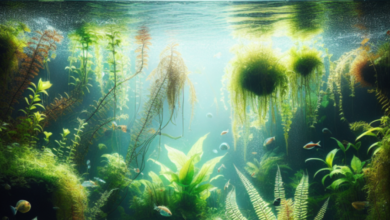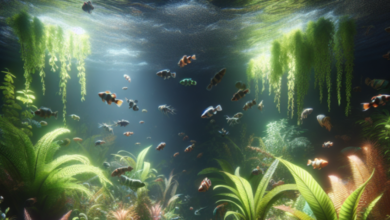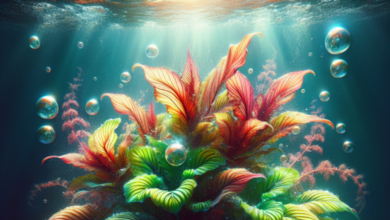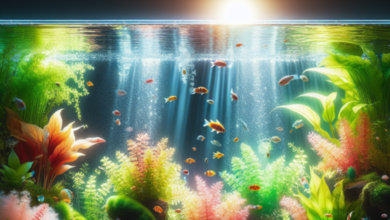Introduction
Are you an aquarium enthusiast looking to create a thriving underwater ecosystem? The secret to achieving vibrant plant growth lies in selecting the perfect substrate for your aquatic plants. In this article, we will explore the world of aquarium plant substrates and uncover the ultimate choice that will unlock the full potential of your aquatic plants. From understanding the importance of substrate to choosing the right type and maintaining its optimal conditions, we will delve into every aspect to help you create a flourishing underwater paradise.
Why Does Substrate Matter?
Before we dive into the details of the ultimate aquarium plant substrate, let’s first understand why substrate matters in the first place. Substrate, the material covering the bottom of the aquarium, plays a crucial role in providing a stable foundation for your plants to root, absorb nutrients, and develop strong root systems. It acts as a reservoir for essential nutrients, anchors the plants in place, and aids in the natural biological processes within the aquarium.
The Essential Characteristics of a Superior Substrate
To ensure vibrant growth and the overall health of your aquatic plants, it is important to consider the following characteristics when choosing a substrate:
1. Nutrient-Rich Composition
A superior aquarium plant substrate should be rich in essential nutrients that are vital for plant growth. These nutrients include macronutrients, such as nitrogen, phosphorus, and potassium, as well as micronutrients like iron, manganese, and zinc. The substrate should have a balanced composition to meet the nutritional requirements of your plants.
2. Optimal Particle Size
The particle size of the substrate is crucial as it determines the ease of root penetration and water circulation. Ideally, a substrate with a mix of particle sizes ranging from fine to coarse provides a favorable environment for the roots to spread and absorb nutrients effectively.
3. High Porosity
A good substrate should be highly porous, allowing for efficient water circulation and oxygenation. This promotes the growth of beneficial bacteria and prevents anaerobic conditions that can be harmful to both plants and fish.
4. pH Buffering Capacity
Maintaining a stable pH level is essential for the well-being of your aquatic plants and inhabitants. An ideal substrate should possess pH buffering capacity, helping to stabilize the pH level within the desired range for optimal plant growth.
5. Non-Compaction
Compacted substrate can hinder root growth and nutrient absorption. It is important to choose a substrate that does not compact easily, allowing roots to penetrate and spread freely.
Types of Aquarium Plant Substrates
Now that we have a clear understanding of the essential characteristics, let’s explore the different types of aquarium plant substrates available:
1. Gravel
Gravel is a popular choice among aquarium hobbyists due to its affordability and ease of maintenance. It comes in various sizes and colors, allowing for creative aquascape designs. However, gravel alone may not provide sufficient nutrients for demanding plants, requiring additional fertilization.
2. Sand
Sand is another commonly used substrate that provides a natural look to the aquarium. It is easy to clean and allows for good root penetration. However, fine-grained sand can sometimes compact, limiting water circulation and oxygenation.
3. Clay-Based Substrates
Clay-based substrates, such as laterite, are known for their high nutrient content. They provide an excellent source of essential minerals and help in long-term plant growth. However, they can be messy during initial setup and require careful rinsing to prevent cloudiness in the water.
4. Aquasoils
Aquasoils are specifically designed substrates for planted aquariums. They are composed of nutrient-rich materials and often contain volcanic ash or peat moss, which aids in maintaining optimal pH levels. Aquasoils provide a complete package of essential nutrients and promote healthy root growth.
5. Mineralized Topsoil
Mineralized topsoil involves utilizing organic soil as a base layer covered by a cap layer, such as gravel or sand. The organic soil provides a rich source of nutrients, while the cap layer prevents cloudiness and nutrient leaching. This method is cost-effective and highly beneficial for plant growth.
Maintaining Optimal Substrate Conditions
Once you have chosen the ultimate aquarium plant substrate, it is crucial to maintain optimal conditions to ensure the continuous growth and well-being of your aquatic plants. Here are some key aspects to consider:
1. Fertilization
While a nutrient-rich substrate provides a good foundation, periodic fertilization is necessary to replenish essential nutrients that may be depleted over time. Liquid fertilizers or root tabs can be used to supplement the substrate’s nutrient content.
2. Water Circulation and Aeration
Proper water circulation and aeration are essential to prevent the accumulation of stagnant areas that can lead to anaerobic conditions. Use of a suitable filtration system and air stones will help maintain a healthy environment for both plants and fish.
3. Regular Cleaning
Regular substrate maintenance, such as vacuuming debris and removing excess waste, is crucial to prevent the buildup of harmful substances. This will help maintain water quality and prevent any negative impact on plant growth.
4. Monitoring pH Levels
Monitor the pH levels regularly to ensure they remain within the desired range for optimal plant growth. pH test kits are readily available and can help you make necessary adjustments if needed.
5. Light and CO2 Requirements
In addition to substrate and nutrients, providing appropriate lighting and carbon dioxide (CO2) supplementation is essential for robust plant growth. Consider investing in quality aquarium lights and CO2 injection systems to create an optimal environment for your aquatic plants.
Conclusion
By now, you have gained a comprehensive understanding of the importance of substrate for aquarium plant growth and the various options available. Remember to choose a substrate that meets the essential characteristics of a superior substrate, such as nutrient richness, optimal particle size, high porosity, pH buffering capacity, and non-compaction. Additionally, ensure proper maintenance and environmental conditions to support the continuous growth of your aquatic plants.
FAQ
1. How often should I fertilize my aquarium plant substrate?
Fertilization frequency depends on the specific needs of your plants and the nutrient content of your substrate. It is generally recommended to follow the instructions provided by the fertilizer manufacturer and adjust based on the growth and health of your plants.
2. Can I mix different types of substrates in my aquarium?
Yes, you can mix different types of substrates to achieve desired characteristics. However, ensure compatibility between the substrates and consider the specific requirements of your plants.
3. Is it necessary to use CO2 supplementation for aquarium plants?
While CO2 supplementation is not always necessary, it can significantly enhance plant growth, especially in setups with high light intensity and demanding plant species. It is recommended to monitor the CO2 levels and adjust accordingly.
4. Can I reuse aquarium plant substrate after removing it from an old tank?
It is generally not advised to reuse aquarium plant substrate, as it may have depleted nutrients and may contain accumulated waste. Starting with fresh substrate is preferable for optimal plant growth.
5. How can I prevent algae growth in my aquarium with the chosen substrate?
Maintaining a healthy balance of light, nutrients, and CO2 levels, along with regular maintenance and water changes, can help prevent excessive algae growth. Additionally, introducing algae-eating fish or invertebrates can contribute to algae control.
Now that you have all the knowledge you need, go ahead and unleash vibrant growth in your aquarium with the ultimate plant substrate!




